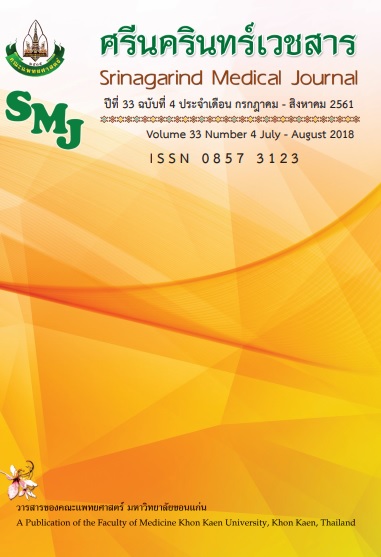Incident Related to Anesthesia at Tertiary Care University Hospital
Keywords:
critical anesthesia incidents, morbidity, mortality, perioperative complications, risk managementAbstract
หลักการและวัตถุประสงค์: การศึกษานี้เป็นการหาอุบัติการณ์ที่เกี่ยวข้องกับการระงับความรู้สึก ที่เกิดขึ้นในระยะเวลา 1 ปี เพื่อหาความสำคัญของแต่ละอุบัติการณ์ที่เกิดขึ้น ปัจจัยที่นำไปสู่เหตุการณ์ดังกล่าวและวิธีป้องกันการเกิดซ้ำ วิธีการศึกษา: การศึกษาเชิงพรรณนา แบบไปข้างหน้าดำเนินการระหว่างเดือนกุมภาพันธ์ 2558 ถึงเดือนมกราคม 2560 โดยอุบัติการณ์ภาวะแทรกซ้อนที่เกิดขึ้นในผู้ป่วยที่เข้ารับการระงับความรู้สึก จะถูกรายงานในแบบฟอร์มมาตรฐานที่ทางโรงพยาบาลกำหนด และรายงานนั้นจะได้รับการตรวจสอบโดยทีมงานบริหารความเสี่ยงของภาควิชาวิสัญญีวิทยาผลการศึกษา: มีจำนวนผู้ป่วยที่เข้ารับการการระงับความรู้สึก 19,163 ราย มีอุบัติการณ์เกิดขึ้น 236 ครั้ง (123: 10,000, 95% CI: 108.5-139.8) พบมากในผู้ป่วยที่มีอายุต่ำกว่า 1 ปี (120: 10,000) ส่วนใหญ่พบใน ASA II (ร้อยละ 38) ที่เข้ารับการผ่าตัดแบบไม่เร่งด่วน (ร้อยละ 71.4) และมักเกิดขึ้นในระหว่างการผ่าตัด (ร้อยละ 65.5) โดยพบอุบัติการณ์ที่เกี่ยวข้องกับระบบทางเดินหายใจมากที่สุด (27.5%) จากการเกิดภาวะพร่องออกซิเจน (11.0:10,000) และการสำลักเศษอาหาร (6.3:10,000) อุบัติการณ์ชนิดที่พบเป็นอันดับสองคือระบบหัวใจและหลอดเลือด (ร้อยละ 24.6) พบภาวะหัวใจหยุดเต้น 25.6:10,000 เสียชีวิต 15:10,000 ปัจจัยที่น่าจะสามารถลดอุบัติการณ์ได้จากการวิเคราะห์โดยคณะกรรมการความเสี่ยงภาควิชา คือ ความระแวดระวังสูงในผู้ให้การระงับความรู้สึก (ร้อยละ 29.5) และประสบการณ์ของวิสัญญีผู้ดูแล (ร้อยละ 22.1) ส่วนวิธีการที่มีส่วนช่วยลดการเกิดอุบัติการณ์คือ ใช้แนวทางการแก้ไขปัญหาผ่านกิจกรรมการประกันคุณภาพ (Morbidity & Mortality activities) ร้อยละ 35.4 และการพัฒนาแนวทางปฏิบัติร้อยละ 31.3สรุป: พบภาวะแทรกซ้อนที่เกี่ยวข้องกับระบบทางเดินหายใจ และ ระบบหัวใจและหลอดเลือด มากที่สุดตามลำดับ การรายงานอุบัติการณ์ภาวะแทรกซ้อน เป็นเครื่องมือที่ดี ช่วยให้บุคคลากรมีความเข้าใจมากยิ่งขึ้นสิ่งที่จะช่วยลดภาวะแทรกซ้อนคือ การพัฒนาบุคลากรวิสัญญีอย่างต่อเนื่อง
Objectives: The purpose of this study was to detect critical incidents involving anesthesia over a one-year period. We identified the magnitude of each incident, factors leading to that incident, and how it could have been prevented.
Methods: A prospective, descriptive study was conducted between February 2015 and January 2016. A standard incident report form was completed for every critical anesthesia incident occurred; these reports were then audited.
Results: From among the 19,163 cases of anesthesia, there were 236 incidents (123:10,000, 95% CI 108.5-139.8). Most frequently, incidents involved patients under 1 year (approximately 120:10,000). Most commonly, incidents occurred among those with a classification of ASAII (38%), among those undergoing elective surgery (71.4%), and during the intraoperative period (65.5%). Incidents related to the airway (27.5%) were the most common; including desaturation (11.0:10,000) and aspiration (6.3:10,000). The second most common type of incident involved the cardiovascular system (24.6%). The rate of cardiac arrest was 25.6:10,000 with a respective mortality of 15:10,000. The factors associated with a lower number of incidents were vigilance (29.5%) and staff experience (22.1%). The corrective strategies suggested were used for quality assurance activities in 35.4% of cases, and practical guidelines were developed in 31.3% of cases.
Conclusion: Most common anesthesia incidents were incidents related to the airway and cardiovascular system. The critical anesthesia incident report is a useful tool for better understanding and prevention of perioperative events accompany with continue quality improvement.
References
Liu EH, Koh KF. A prospective audit of critical incidents in anaesthesia in a university teaching hospital. Ann Acad Med Singapore 2003; 32: 814–20.
Saito T, Wong ZW, Thinn KK, Poon KH, Liu E. Review of critical incidents in a university department of anaesthesia. Anaesthesia and Intensive Care 2015; 43: 238–43.
Webb RK, Currie M, Morgan CA, Williamson JA, Mackay P, Russell WJ, et al. The Australian Incident Monitoring Study: an analysis of 2000 incident reports. Anaesth Intensive Care 1993; 21: 520–8.
Choy CY. Critical incident monitoring in anaesthesia.CurrOpinAnaesthesiol 2008; 21: 183–6.
Flanagan JC. The critical incident technique.Psychol Bull 1954; 51: 327–58.
Hutchinson A, Young TA, Cooper KL, McIntosh A, Karnon JD, Scobie S, et al. Trends in healthcare incident reporting and relationship to safety and quality data in acute hospitals: results from the National Reporting and Learning System. QualSaf Heal Care 2009; 18: 5–10.
Boonmak P, Boonmak S, Sathitkarnmanee T, Chau-In W, Nonlhaopol D, Thananun M. Surveillance of anesthetic related complications at Srinagarind Hospital, KhonKaen University, Thailand. J Med Assoc Thai 2005; 88: 613-22.
Munting KE, Van Zaane B, Schouten ANJ, Wolfswinkel L van, Graaff JC de. Reporting critical incidents in a tertiary hospital: a historical cohort study of 110,310 procedures. Can J Anaesth 2015; 62: 1248-58.
Amucheazi, Ajuzieogu O. Critical incidents during anesthesia in a developing country: A retrospective audit. Anesth Essays Res 2010; 4: 64-8.
Charuluxananan S, Narasethkamol A, Kyokong O, Premsamran P, Kundej S. Study of Model of Anesthesia Related Adverse Event by Incident Report at King Chulalongkorn Memorial Hospital. J Med AssocThail 2011; 94: 78-88.
Gupta S, Naithani U, Brajesh SK, Pathania VS, Gupta A. Critical Incident Reporting in Anaesthesia: A Prospective Internal Audit. Indian J Anaesth 2009; 53: 425-33.
Ali MA, Siddiqui K, Munshi K, Abbasi S. Critical Incidents in Post Anesthesia Care Unit (PACU) at a Tertiary Care Hospital: A Prospective Internal Audit. J AnesthClin Res 2014; 5: 486. doi:10.4172/2155-6148.1000486
Short TG, O’Regan A, Lew J, Oh TE. Critical incident reporting in an anaesthetic department quality assurance programme. Anaesthesia 1993; 48: 3–7.
Dutton RP. Improving Safety Through Incident Reporting. Curr Anesthesiol Rep 2014; 4: 84-9.
Wallace L. Feedback from reporting patient safety incidents--are NHS trusts learning lessons? J Health Serv Res Policy 2010; 15(Suppl 1): 75–8.
Cooper JB, Newbower RS, Long CD, McPeek B. Preventable Anesthesia Mishaps. Anesthesiology 1978; 49: 399–406.
Mahajan RP. Critical incident reporting and learning. Br J Anaesth 2010;105:69–75.
Vincent CA. Analysis of clinical incidents: a window on the system not a search for root causes. QualSaf Health Care 2004; 13: 242–3.
Tewari A, Sinha A. Critical incident reporting: Why should we bother? J Anaesthesiol Clin Pharmacol 2013; 29: 147-8.


